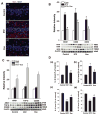Treadmill Exercise Exerts Neuroprotection and Regulates Microglial Polarization and Oxidative Stress in a Streptozotocin-Induced Rat Model of Sporadic Alzheimer's Disease
- PMID: 28157094
- PMCID: PMC5450951
- DOI: 10.3233/JAD-160869
Treadmill Exercise Exerts Neuroprotection and Regulates Microglial Polarization and Oxidative Stress in a Streptozotocin-Induced Rat Model of Sporadic Alzheimer's Disease
Abstract
Recent work has suggested that exercise may be beneficial in preventing or ameliorating symptoms of several neurological disorders, although the mechanism is not entirely understood. The current study was designed to examine the potential beneficial effect of treadmill exercise upon cognitive function in a streptozotocin (STZ)-induced rat model of Alzheimer's disease (AD). Animals underwent treadmill exercise (30 min/day, 5 days/week) for 4 weeks after bilateral STZ intracerebroventricular injection (2.4 mg/kg). We demonstrated that treadmill exercise significantly attenuated STZ-induced neurodegeneration in the rat hippocampal CA1 region and strongly preserved hippocampal-dependent cognitive functioning. Further mechanistic investigation displayed a marked suppression of STZ-induced amyloid-β accumulation and tau phosphorylation. Intriguingly, treadmill exercise remarkably inhibited reactive gliosis following STZ insult and effectively shifted activated microglia from a pro-inflammatory M1 to an anti-inflammatory M2 phenotype, which was correlated with a significantly reduced expression of pro-inflammatory mediators and a corresponding enhancement of anti-inflammatory cytokine expression in the hippocampus. Furthermore, treadmill exercise caused a robust suppression of oxidative damage as evidenced by significantly reduced peroxynitrite production, lipid peroxidation, and oxidized DNA damage. Finally, treadmill exercise strongly attenuated STZ-induced mitochondrial dysfunction manifested by a dramatically elevated intra-mitochondrial cytochrome c oxidase activity and ATP synthesis, and markedly inhibited neuronal apoptosis in the hippocampus. These findings demonstrate that treadmill exercise has a multifactorial effect to attenuate many of the pathological processes that play a key role in AD, and provide further support for the beneficial role of exercise as a potential therapeutic option in AD treatment.
Keywords: Alzheimer’s disease; cognition; exercise; inflammation; microglia; oxidative stress; streptozotocin.
Figures






Similar articles
-
Beneficial Effects of Exercise Pretreatment in a Sporadic Alzheimer's Rat Model.Med Sci Sports Exerc. 2018 May;50(5):945-956. doi: 10.1249/MSS.0000000000001519. Med Sci Sports Exerc. 2018. PMID: 29232315 Free PMC article.
-
Methylene blue improves streptozotocin-induced memory deficit by restoring mitochondrial function in rats.Brain Res. 2017 Feb 15;1657:208-214. doi: 10.1016/j.brainres.2016.12.024. Epub 2016 Dec 27. Brain Res. 2017. PMID: 28034723
-
Exercise-induced upregulation of TRIM9 attenuates neuroinflammation in Alzheimer's disease-like rat.Int Immunopharmacol. 2025 Jan 10;144:113676. doi: 10.1016/j.intimp.2024.113676. Epub 2024 Nov 23. Int Immunopharmacol. 2025. PMID: 39580859
-
Streptozotocin Intracerebroventricular-Induced Neurotoxicity and Brain Insulin Resistance: a Therapeutic Intervention for Treatment of Sporadic Alzheimer's Disease (sAD)-Like Pathology.Mol Neurobiol. 2016 Sep;53(7):4548-62. doi: 10.1007/s12035-015-9384-y. Epub 2015 Aug 23. Mol Neurobiol. 2016. PMID: 26298663 Review.
-
Microglial polarization in Alzheimer's disease: Mechanisms, implications, and therapeutic opportunities.J Alzheimers Dis. 2025 Mar;104(1):3-13. doi: 10.1177/13872877241313223. Epub 2025 Feb 2. J Alzheimers Dis. 2025. PMID: 39894910 Review.
Cited by
-
Qi Fu Yin ameliorates neuroinflammation through inhibiting RAGE and TLR4/NF-κB pathway in AD model rats.Aging (Albany NY). 2023 Nov 22;15(22):13239-13264. doi: 10.18632/aging.205238. Epub 2023 Nov 22. Aging (Albany NY). 2023. PMID: 38006400 Free PMC article.
-
Therapeutic non-invasive brain treatments in Alzheimer's disease: recent advances and challenges.Inflamm Regen. 2022 Oct 3;42(1):31. doi: 10.1186/s41232-022-00216-8. Inflamm Regen. 2022. PMID: 36184623 Free PMC article. Review.
-
The protective effect of biotin supplementation and swimming training on cognitive impairment and mental symptoms in a rat model of Alzheimer's disease: A behavioral, biochemical, and histological study.Heliyon. 2024 Jun 7;10(13):e32299. doi: 10.1016/j.heliyon.2024.e32299. eCollection 2024 Jul 15. Heliyon. 2024. PMID: 39035497 Free PMC article.
-
Neuroprotective effects of resistance physical exercise on the APP/PS1 mouse model of Alzheimer's disease.Front Neurosci. 2023 Apr 6;17:1132825. doi: 10.3389/fnins.2023.1132825. eCollection 2023. Front Neurosci. 2023. PMID: 37090809 Free PMC article.
-
Glymphatic imaging and modulation of the optic nerve.Neural Regen Res. 2022 May;17(5):937-947. doi: 10.4103/1673-5374.324829. Neural Regen Res. 2022. PMID: 34558505 Free PMC article.
References
-
- Myhrer T. Neurotransmitter systems involved in learning and memory in the rat: A meta-analysis based on studies of four behavioral tasks. Brain Res Brain Res Rev. 2003;41:268–287. - PubMed
-
- Simonian NA, Coyle JT. Oxidative stress in neurodegenerative diseases. Annu Rev Pharmacol Toxicol. 1996;36:83–106. - PubMed
-
- Behl C, Holsboer F. Oxidative stress in the pathogenesis of Alzheimer’s disease and antioxidant neuroprotection. Fortschr Neurol Psychiatr. 1998;66:113–121. - PubMed
-
- Koliatsos VE, Kecojevic A, Troncoso JC, Gastard MC, Bennett DA, Schneider JA. Early involvement of small inhibitory cortical interneurons in Alzheimer’s disease. Acta Neuropathol. 2006;112:147–162. - PubMed
-
- Akama KT, Van Eldik LJ. Beta-amyloid stimulation of inducible nitric-oxide synthase in astrocytes is interleukin-1beta- and tumor necrosis factor-alpha (TNFalpha)-dependent, and involves a TNFalpha receptor-associated factor- and NFkappaB-inducing kinase-dependent signaling mechanism. J Biol Chem. 2000;275:7918–7924. - PubMed
Publication types
MeSH terms
Substances
Grants and funding
LinkOut - more resources
Full Text Sources
Other Literature Sources
Medical
Miscellaneous

